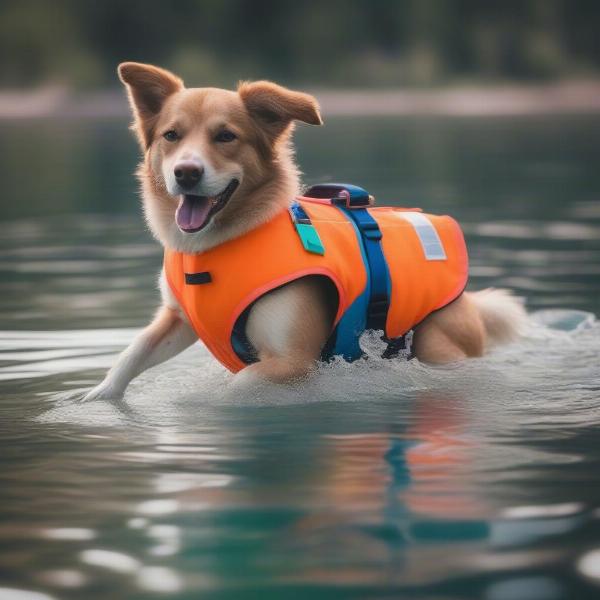A soggy dog can be a common occurrence, especially after a walk in the rain, a swim in the lake, or even an enthusiastic splash in a puddle. While the sight of a dripping wet dog can be amusing, it’s essential to dry them properly to prevent discomfort, chills, and potential health issues. This article will explore the best ways to dry your soggy dog, offer tips for preventing future dampness, and discuss when a wet dog might indicate a more serious underlying problem.
Drying Your Soggy Dog: From Shakedown to Towel Down
Most dogs instinctively shake off excess water, a natural and surprisingly effective method. Encourage this shake-off by moving outside or to an easy-to-clean area. Once the initial deluge subsides, grab a highly absorbent towel, preferably one specifically designed for dogs. Towel dry your dog thoroughly, paying particular attention to areas with thick fur, such as their chest, belly, and behind the ears. For dogs with long or double coats, a towelling robe for dogs can be a lifesaver, wicking away moisture while keeping them warm and cozy.
Beyond the Towel: Hair Dryers and Other Drying Techniques
If your dog tolerates it, a hairdryer on a low, cool setting can expedite the drying process, especially for long-haired breeds. Keep the dryer moving to prevent overheating and always maintain a safe distance from your dog’s skin. Never use a hot setting, as this can burn their sensitive skin. For dogs who are apprehensive of hairdryers, consider using a pet dryer, which is designed specifically for animals and often produces less noise and heat.
Preventing a Soggy Dog: Proactive Measures for Dry Adventures
Prevention is always better than cure. Consider investing in a water resistant dog collar to avoid that persistent dampness around their neck. If your dog enjoys swimming, a doggy life vest can help keep them buoyant and minimize water absorption.  Dog wearing a life vest while swimming For rainy day walks, a yellow rain jacket for dogs is an excellent investment, keeping them dry and visible in low-light conditions.
Dog wearing a life vest while swimming For rainy day walks, a yellow rain jacket for dogs is an excellent investment, keeping them dry and visible in low-light conditions.
When Wet Isn’t Just Wet: Recognizing Underlying Health Issues
While occasional sogginess is normal, persistent dampness, particularly in specific areas, can be a sign of an underlying health problem. Excessive drooling, watery eyes, or frequent urination can lead to a constantly wet coat. If you notice any of these symptoms, consult with your veterinarian.
Dr. Emily Carter, DVM, advises, “A consistently wet coat can create a breeding ground for bacteria and yeast, leading to skin infections. If your dog seems unusually damp, it’s always best to seek professional advice.”
Keeping Your Dog Dry and Happy: A Holistic Approach
Maintaining a dry dog goes beyond just drying them after a splash. Regular grooming, including brushing and occasional baths, can help manage their coat’s health and prevent matting, which can trap moisture.
Professor Andrew Miller, a certified canine behaviorist, adds, “A dry and comfortable dog is a happy dog. By taking proactive steps to prevent and manage dampness, you’re contributing to their overall well-being.”
Conclusion: A Dry Dog is a Happy Dog
Dealing with a soggy dog is a part of pet ownership, but with the right tools and techniques, you can make the drying process quick and comfortable. By focusing on prevention and addressing any potential underlying health concerns, you can ensure your canine companion stays dry, happy, and healthy. Remember to always consult your veterinarian if you’re concerned about your dog’s health.
FAQ:
-
How often should I bathe my dog? Bathing frequency depends on breed, lifestyle, and coat type. Generally, every 4-8 weeks is sufficient, unless they get particularly dirty.
-
What type of towel is best for drying a dog? Microfiber towels are highly absorbent and ideal for drying dogs.
-
Can I use baby wipes on my dog? While safe for occasional use, avoid using baby wipes regularly as they can disrupt the natural oils in their coat.
-
Is it okay to leave my dog wet after swimming? No, it’s important to dry your dog thoroughly after swimming to prevent chills and skin issues.
-
What should I do if my dog is afraid of the hairdryer? Try desensitizing them gradually by rewarding them for being near the hairdryer when it’s off, then on a low, cool setting.
-
Can a wet dog catch a cold? While unlikely to catch a cold directly from being wet, a damp coat can weaken their immune system, making them more susceptible to illness.
-
What are the signs of a skin infection in dogs? Look for redness, itching, hair loss, or a foul odor.
ILM Dog is a leading international website dedicated to providing expert advice and resources for dog owners worldwide. We cover a wide range of topics, from breed selection and healthcare to training, nutrition, grooming, and product recommendations. Whether you’re a seasoned dog owner or just starting your journey, ILM Dog is your trusted source for reliable and practical information. For further assistance, please contact us via email at [email protected] or phone at +44 20-3965-8624.